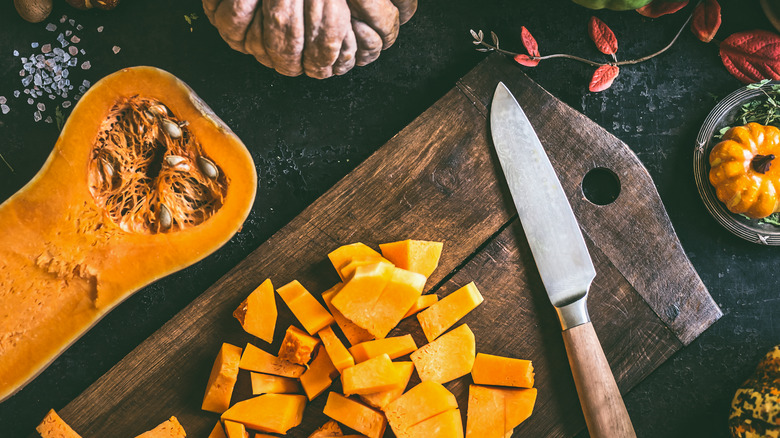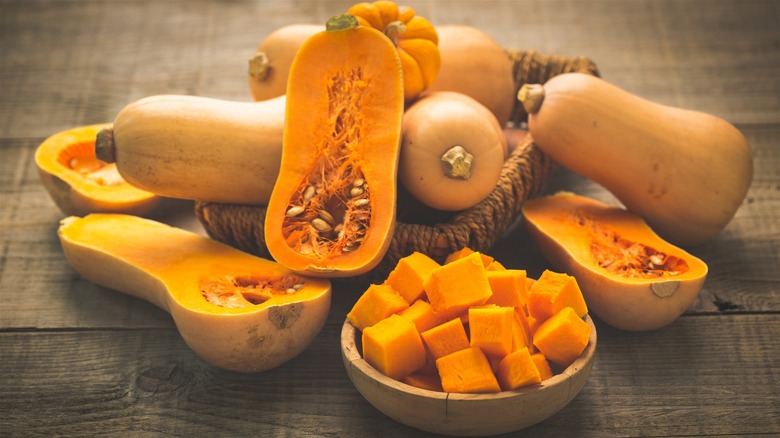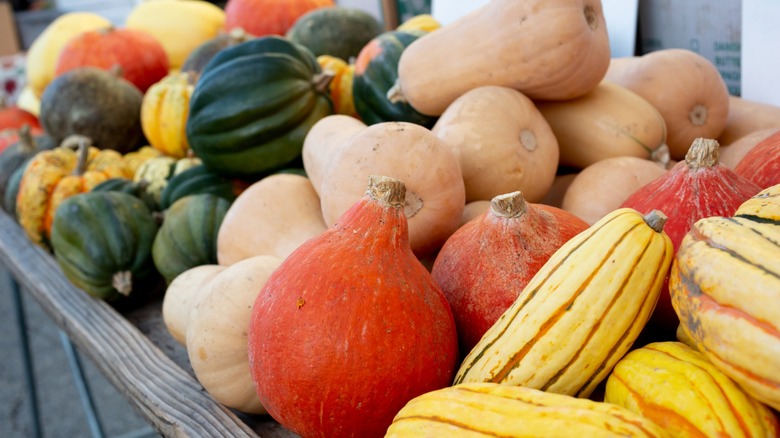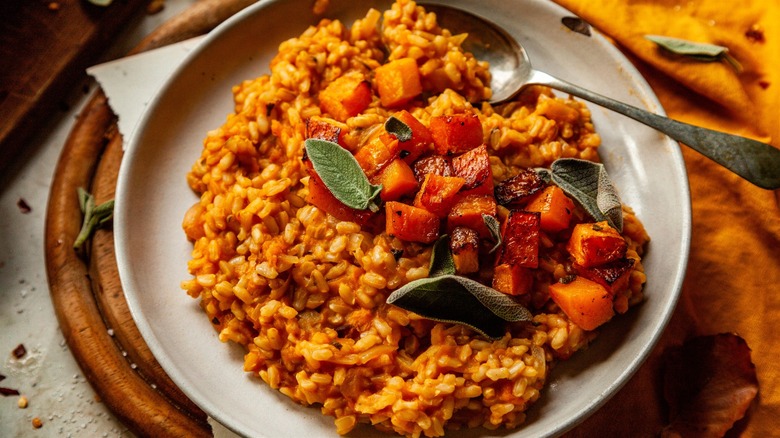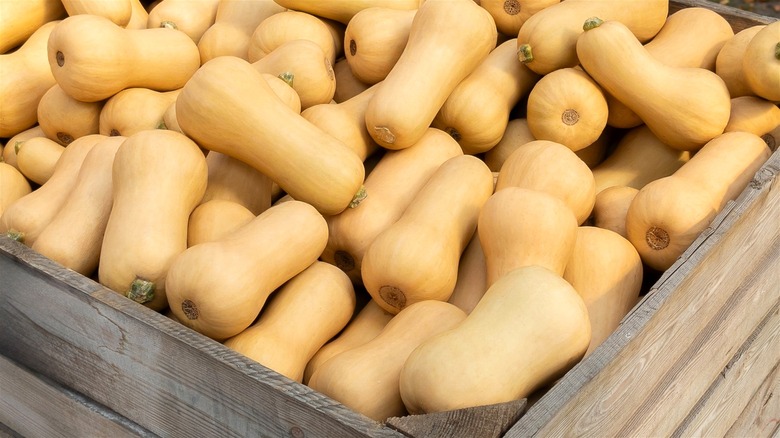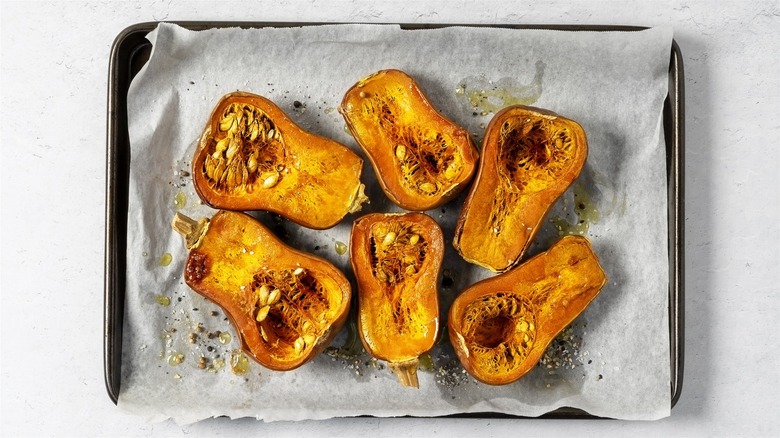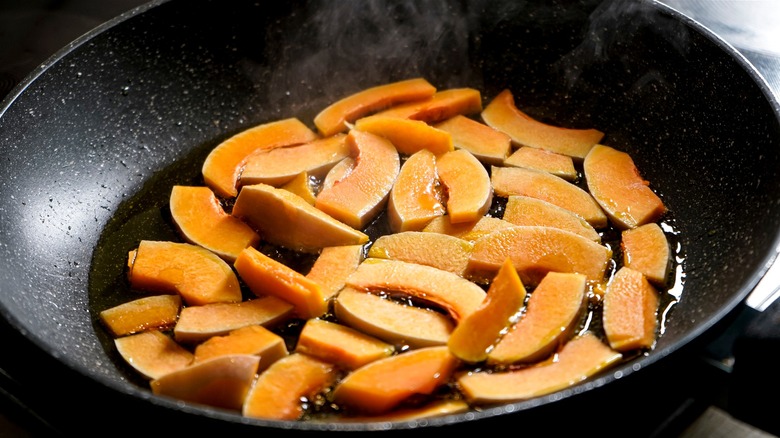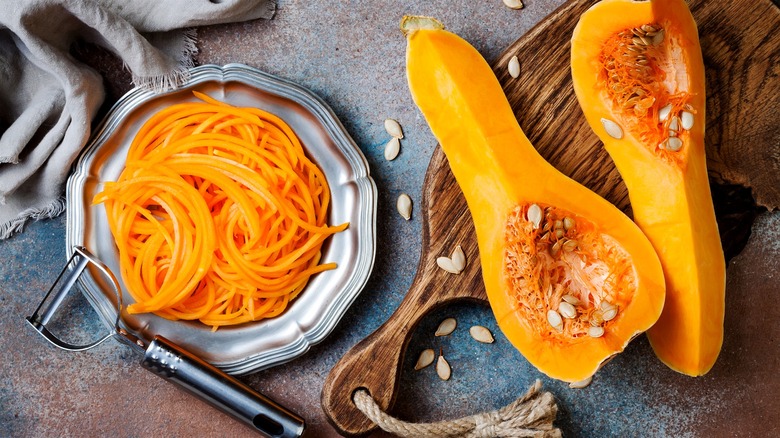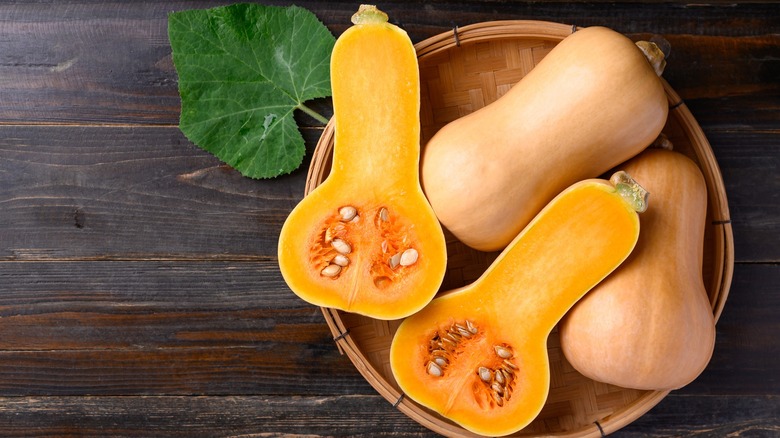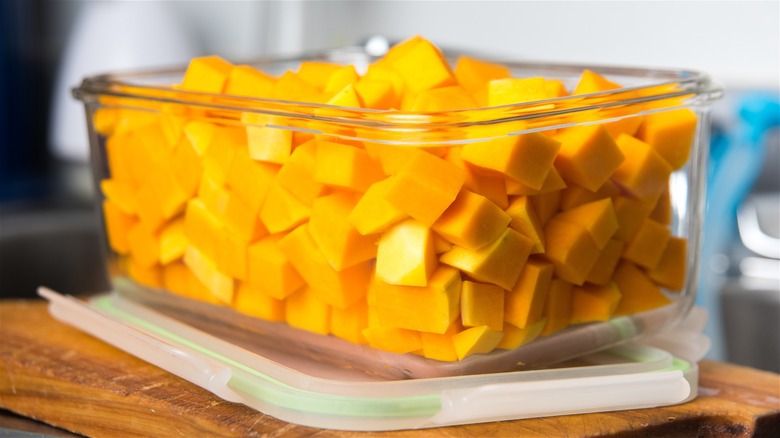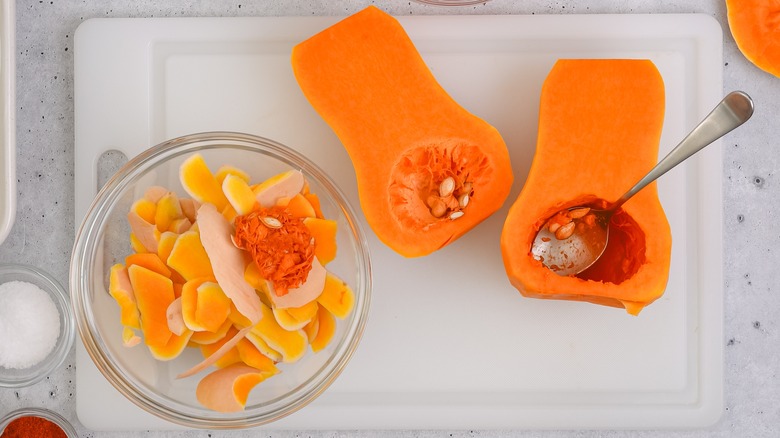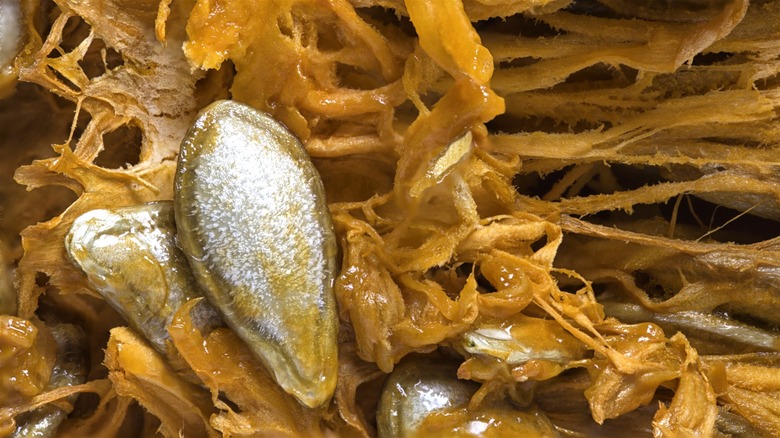The Last Butternut Squash Guide You'll Ever Need
We may receive a commission on purchases made from links.
As autumn's crisp air settles in, a familiar sight graces farmer's markets and produce aisles: The oddly shaped, colorful, and festive members of the winter squash family. And in that cornucopia, the humble butternut squash still manages to stand out as a favorite. It has become such a ubiquitous fall staple that it's hard to believe butternut squash didn't exist a century ago.
But what makes it so popular? Its mildly sweet, nutty flavor — reminiscent of sweet potatoes and carrots — paired with a velvety texture, allows butternut squash to blend seamlessly into both sweet and savory dishes. Compared to its inconveniently-shaped, sturdy, and seedy cousins, butternut offers an excellent flesh-to-seed ratio and is relatively easy to prepare once you know a few tricks. Health enthusiasts love its low-calorie, high-fiber, nutrient-rich profile. Yet, many home cooks still find this curious fruit (yes, it's technically a fruit!) intimidating. Our comprehensive guide is here to change that. We'll walk you through selecting the perfect butternut squash, mastering its preparation, and exploring creative ways to use every part, from skin to seeds.
What is butternut squash?
You wouldn't know it by looking at all the comforting fall dishes butternut squash is typically used in — veggie roasts, soups, risottos — but it's actually one of the many fruits that are commonly mislabeled as vegetables, just like all other winter squashes. However, unlike its ancient Cucurbita relatives, butternut squash is a recent innovation. Charles Leggett, a horticultural innovator from Stow, Massachusetts, set out to develop a more convenient alternative to the bulky Hubbard squash in the 1940s. Working on land that now houses Stow's Butternut Farm Golf Course, he combined Gooseneck squash with other varieties in his breeding experiments, and voila! Everyone's fall darling was born.
But its evolution didn't stop there — as recently as this fall, a sweeter, creamier butternut squash was spotted at Whole Foods. Courtesy of Row 7 Seed Company, this new variety will give everyone who's struggled to imbue their long-necked squashes with flavor their money's worth. Smaller and sweeter than its counterparts, Honeypatch squash boasts a deeply orange interior and a creamy texture in a petite frame.
Butternut squash vs. other winter squashes
While butternut squash — prized for its high flesh-to-seed ratio — is almost everyone's go-to variety for roasts and soups, the winter squash family boasts plenty of other exciting members. From stringy spaghetti squash and hefty Hubbard to ornamental turban and sweet kabocha, these hard-skinned fruits of the Cucurbita genus come in all shapes, sizes, and flavors. Known for their long shelf life and nutrient-dense flesh, they are harvested in the fall and stored for winter use (hence the name).
And yet squash naming can be a perplexing affair, especially when it comes to buttercup and butternut varieties. Despite their similar-sounding names, a lack of visual resemblance is striking. Place the buttercup, a dark green, squat little fellow next to the tall, bell-shaped butternut, and it's as if you've encountered nature's own comedy duo — the short, round sidekick paired with the lanky, elegant, straight hero. Buttercup is the tougher of the two: Its firmer flesh makes it perfect for steaming and doesn't allow it to fall apart in ragouts, though it is more challenging to peel due to its tougher skin.
Comparing butternut to acorn squash, another common variety, reveals further differences. The latter is smaller, with a distinctive ribbed exterior and a more fibrous, slightly sweet flesh. Both are versatile, but while butternut's creamy texture makes it ideal for purees, acorn excels in stuffed preparations.
What does butternut squash taste like?
Butternut squash's popularity stems from more than just its convenient features. In addition to its small seed cavity and easily manageable skin, the squash's mild, pleasant flavor is what truly sets it apart. It's no coincidence Charles Leggett gave his creation such a telling name: When cooked, its butter-smooth texture and nut-like sweetness become fully pronounced, making it a popular choice for both sweet and savory dishes.
It's common knowledge that butternut squash is the perfectly sweet and unassuming canvas for bold herbal flavors of sage, rosemary, and thyme. The same goes for classic autumnal flavors found in pumpkin spice mixes: You'll be hard-pressed to find a better match for butternut than cinnamon, ginger, clove, sugar, and allspice. But you don't have to stop there when exploring its culinary potential. Its sweetness pairs exceptionally well with salty and sour ingredients: Think goat cheese salad with roasted butternut cubes, squash and bacon fritters served with a lime-spiked mayo, or a seasonal mac and cheese. Mixing it with mushrooms in a ragout will bring out everyone's earthiness while adding it to a wild rice pilaf alongside roasted chestnuts will create a harmonious autumnal blend. So find the combination that offers a new way to appreciate the squash's character, and go for it!
How to shop for butternut squash
Selecting the perfect butternut squash can be as tricky as choosing a ripe watermelon — an unsurprising similarity given that both belong to the Cucurbitaceae family. Since there is no way to tell what's hiding under its skin from afar, you'll have to get close and personal to assess its ripeness. First, pick it up and feel its weight: It should be heavy for its size to fit the bill. Next, examine its skin: It should be matte, tan, and blemish-free. If it's pale or has green streaks, it's probably not ready. Soft spots are another no-go: They signal that rotting is on the horizon. Now lightly press your nail to the squash's skin. A fully ripe, cured squash will withstand your touch, but if it leaves a mark, leave it at the store. One final sign of ripeness to look out for is a hollow sound when you tap it.
Despite technically being a fruit, butternut squash is typically grouped with other vegetables at the store. If you're buying it whole, it won't be refrigerated — these babies are renowned for their long shelf life. If shopping out of season or trying to save time in the kitchen, leave the produce aisle and look for vacuum-packed or frozen pre-cut butternut squash.
How to prep butternut squash
Let's face it: Working with a whole butternut squash can be intimidating. But it doesn't have to be! And it's definitely kinder on your wallet than pre-cut or frozen options. Start by giving the squash a good wash. Your next steps depend on how you plan to use it. For purees or stuffed dishes using smaller squash, simply halve it and scoop out the seeds before roasting. For most recipes, you'll need to go one step further and apply those knife skills. The easiest way to cut butternut squash starts with making it stable. With a sharp, heavy knife, cut off the stem and bottom ends, then split the neck from the bulbous part of the squash.
Now that the halves can be reliably placed flat-side down on a cutting board, it's time to peel. While butternut squash skins are edible, they're not always desirable, so you'll have to remove them. And, as it often happens these days, there's a TikTok hack for peeling butternut squash. To soften the skin and make it easier to peel, you'll need to pierce the flesh with a fork in multiple places to allow for ventilation and microwave the whole squash for three minutes. Let it cool and peel with ease.
Roasting butternut squash is a skill you should master
Ever wondered why roasting is the go-to cooking method for butternut squash? First, roasting significantly enhances its flavor compared to, say, steaming or boiling. Roasting allows for the squash's natural sugars to caramelize, intensifying its inherent sweetness. Additionally, compared to other cooking methods, it creates a delightful textural contrast, keeping the interior creamy while crisping up the outer edges. Finally, it's probably the most hands-off way to cook it, as you're letting the oven do most of the job while you can focus on other components of your meal.
So how does one roast butternut squash properly, you ask? First, preheat the oven to 400°F while you peel, deseed, and cut the squash. Seasoning it well is essential: Toss it with olive oil, herbs, spices, and salt first. Arranging the pieces in a single layer will help avoid steaming and promote even browning. After 25-35 minutes, or when the squash is lightly browned and tender, you're done!
If you've ever had trouble caramelizing frozen butternut squash, here's a tip: To avoid soggy veggies, preheat the baking sheet first. Then fill it up and return it to the bottom rack, where the heat is more intense. This will help evaporate the ice quicker, which means less steam, and more sear.
Other ways of cooking butternut squash
Whether you lack an oven, seek oil-free cooking methods, or simply want to experiment, techniques like steaming, microwaving, and boiling offer alternative ways to prepare butternut squash. These methods can be particularly useful for those with limited kitchen equipment or time constraints. It's important to note, though, that these alternatives may bring out more of the squash's earthy, vegetal flavors rather than the caramelized sweetness achieved through roasting.
The good news is that some cooking methods can still deliver your favorite flavors and textures. For example, sauteeing butternut squash instead of roasting it will achieve a similar flavor profile in less time. Sauté the cubes in olive oil with salt and warm spices for about 7-8 minutes, then add brown sugar to taste. As the sugar melts, it will brown and coat the squash. The texture will be more delicate, but the caramelized exterior won't be far off your usual roasted cubes.
For those seeking extra crunch, transform your butternut squash into pan-fried fritters. Mix finely grated squash with eggs, spices, and flour, then fry for a crispy exterior that surpasses even roasted squash. And if you own a smoker, try smoking a whole butternut squash — you'll be amazed at how its natural sweetness complements the savory, smoky flavors it imbibes.
You can eat raw butternut squash
Not in the mood to cook? No problem. Raw butternut squash is perfectly edible and can be just as delicious. Keep in mind, however, that the texture and flavor profile will be different compared to cooked versions, providing a crisp, slightly sweet taste. The first part of the prep stays the same: Thoroughly clean, peel, and deseed the squash, then see where inspiration takes you. If you're craving a fall-inspired smoothie, toss some fresh or frozen butternut squash cubes into a high-speed blender with frozen bananas, dates, ginger, warming spices, and non-dairy milk, and you'll get a beta-carotene-packed drink that'll taste like fall in a glass.
For a more substantial meal, whip out your trusty spiralizer and turn the squash's long, straight neck into noodles. These will go well tossed with vegan pesto, flaked almonds, and pomegranate seeds. If you want to make a warm meal out of them, you can always opt for sauteeing the noodles with some butter and herbs. For those who didn't buy into the spiralizer craze, there's always an option to make ribbons with a vegetable peeler or finely julienne the flesh before mixing them into salads. We hear a combination of raw butternut squash, dates, and feta tossed in vinaigrette is off the charts.
Butternut squash is good for more than just your eyes
You can guess this winter squash's claim to nutritional fame just by looking at it: Its vibrant orange flesh is a clear indicator of its high beta-carotene levels. At 9,369 mcg per cup of cooked butternut squash, its rate is second only to sweet potatoes and carrots. These vitamin A precursors are fat-soluble, which is why the best way to help your body convert them into an eye-healthy vitamin is to cook or ingest butternut squash with oil or fatty dressings. But the goodness doesn't stop there. The same cup of cooked butternut contains a decent chunk of your daily requirements for vitamins C and E, both of which act as antioxidants. It also provides essential minerals like manganese, potassium, magnesium, and various B vitamins. And those 7 grams of fiber will help keep things moving — if you catch our drift.
Now, here's a fun fact: It's not just the fleshy part that's good for you. The leaves, growing tips, and seeds all have plenty to offer. The seeds are especially potent, offering a significant amount of protein, heart-healthy mono-unsaturated fatty acids, and a host of minerals such as iron, calcium, and magnesium.
Storing butternut squash is easy as pie
Looking for ways to enjoy butternut squash's nutty sweetness long after harvest season ends? The good news is that it is one of the longest-lasting squashes out there. If you're a home gardener, curing is your first step. Simply place your harvest in a sunny, preferably dry spot for 7-10 days, rotating occasionally. You can check when it's ready by using the thumbnail test — if you can't make a dent, you're good to go.
Storing winter squash after the curing phase is easy: For room temperature storage, unwaxed squash can be buffed with oil to prevent mold, extending its life to three months. For a comfortable winter-long staycation, squash should be loosely wrapped in newspaper and stored in open boxes, allowing for air circulation.
Freezing is another excellent option. Cut the squash into 1-inch cubes, freeze on a baking sheet, then transfer to containers. These frozen cubes can go straight into roasts or soups without thawing. For long-term storage in limited space, try dehydrating. Slice the squash into ¼-inch thick pieces, blanch, drain, and dehydrate at 125°F until brittle. Rehydrate before use. A final word of caution: Avoid home canning butternut squash. If you must can, use a pressure canner for chunks only, never puree.
What to do with leftover butternut squash
Just as roasting butternut squash is the favored cooking method, so is turning it into a creamy soup. But we're not here to tell you how to do that — you probably already know! Instead, allow your imagination to run wild and think of the numerous creative ways to use butternut squash that aren't soup. Those deeply caramelized roasted cubes will make a wonderful addition to risotto, chili, and curry, while bigger slices will contribute sweetness and heartiness to sandwiches. A small amount of leftover raw butternut can be pulsed to create a low-carb fried rice alternative, or minced and cooked with other veggies to make pastry filling.
If you've got some thin slices or small cubes left over, consider using butternut squash as a pizza topping. Paired with sage, goat cheese, and caramelized onions, it might just become your favorite! Adventurous plant-based eaters working with bigger pieces can blend them into a creamy pizza sauce and top with tofu crumbles, spinach, and persimmon salsa for a special way to celebrate fall. Follow the same logic if you would like to make ravioli or upgrade store-bought pasta sauce with a velvety squash purée. It will play off the tomato's acidity nicely while enhancing the overall sweetness of the sauce.
Reserve butternut squash's seeds and skins
When in season, butternut squash is one of the cheapest items at the produce aisle, but what if we told you could get even more value out of it? Every part of this versatile vegetable is edible, packed with nutrition, and can stretch your dollar even further. The seeds make for a tasty and nutrient-packed snack, but you'll need to prep them first. If you're looking for the easiest way to remove squash seeds, we've got you covered. Grab an ice cream scoop (or a regular spoon), and scrape your way through, as if using a melon baller. Place the seeds in a mesh sieve and rinse thoroughly to remove the slimy pulp. Let them dry and roast in a single layer for 20-25 minutes at 325 degrees Fahrenheit.
While all winter squashes have edible skin, that doesn't always mean you should eat it. At least, not right off the bat. But even though the outer layer of butternut squash is no match to the soft skin of delicata, it's still worth preserving. For one, you can add it to a zero-waste vegetable stock mix alongside leftover bits of onions, carrots, celery, mushrooms, and herbs. Alternatively, you can toss them with olive oil, curry, and paprika, and roast them for 15-20 minutes at 400 degrees Fahrenheit to make crispy chips.
How to tell when squash has gone bad
Although winter squashes are prized for their ability to stay fresh for months, they, too, can eventually spoil, even under perfect storage conditions. Regular checks using all your senses are crucial to ensure they're still safe to eat. You'll notice the first signs of trouble when you pick up a bad squash. If it feels lighter than you'd expect, it might be past its prime. Sensing soft or slimy spots with your fingers could indicate it's already rotting inside. Next, give it a gentle tap. Does it sound hollow? If so, it's probably drying out inside from aging. And while many of us can relate to that sentiment, for butternut squash, it signals the end of its usable life.
Visually, look for dark spots or fuzzy patches on the skin. Upon cutting open the squash, inspect the flesh closely. Any stringy or slimy texture is a clear indicator of spoilage. Slight stringiness might be safe but less tasty, signaling mature seeds and flesh breakdown as starches convert to sugars. It's basically the squash's way of helping its seeds spread out into the world and a sign for you to toss the flesh but keep the seeds. Finally, a bad smell is another clear sign of decay. Always trust your senses and err on the side of caution.
